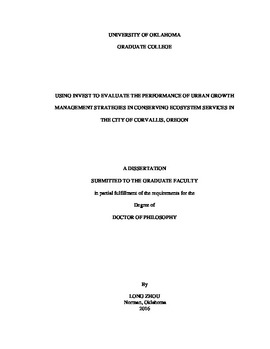| dc.description.abstract | The world is undergoing a sustained wave of urbanization and through changing landuse and land cover, urbanization has been posing threats to “eco-environments” at various scales (Wang et al 2002). Urban growth management strategies including comprehensive plan with an urban growth boundary have been widely applied at both local and regional scales in the United States to control urban growth and conserve natural resources (Bengston et al 2003). Scholars have studied the performance of Urban Growth Management in environmental conservation, with the results varying due to different scales and research perspectives (Frenkel, 2004; Nelson 1992; Gordon, et al, 2009; Cathcart, et al 2006; Robinson, et al 2005; Kline and Alig, 1999). Through reviewing relevant literature, the author found that few studies explore this issue based on ecosystem service quantification, which could directly act as an indicator of the effectiveness of environmental conservation under different planning policies (Heldal and Baszka 2012).
The InVEST (Integrated Value of Ecosystem Services Tradeoffs) modeling program developed by the Natural Capital Project at Stanford University quantifies various ecosystem services under different planning scenarios. This research uses InVEST 3.2.0 on the parcel level to evaluate the City of Corvallis’s current Comprehensive Plan in terms of alleviating future urbanization’s impacts on environmental quality and conserving ecosystem services in purifying stormwater and storing carbon. Through spatial and temporal comparisons, the conclusion is made that the City’s current Urban Growth Management conserves the land of high ecological value in carbon storage, but does not protect the land of high ecological value in stormwater purification. Using ecological unit monetary values from previous studies and the ecosystem service quantification results generated from InVEST, ecological values of each parcel are converted into a monetary value. Based on these monetized values, this research proposes a revised comprehensive plan for the City. The new plan directs future urbanization into the lands with least ecological values and conserves the lands with most ecological values while still matching the City’s estimated demand for developable land for different land uses. | en_US |
